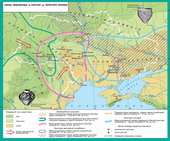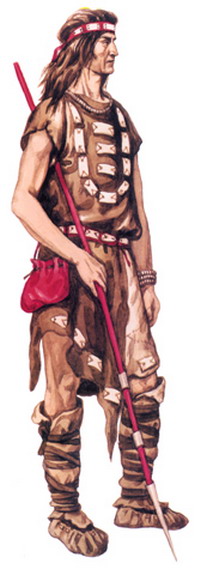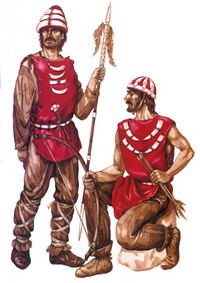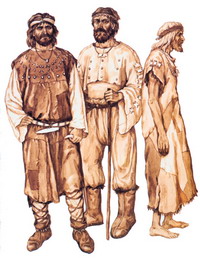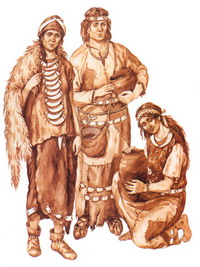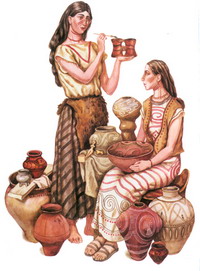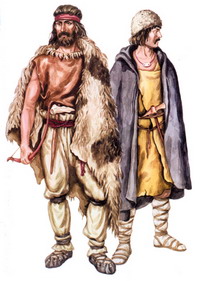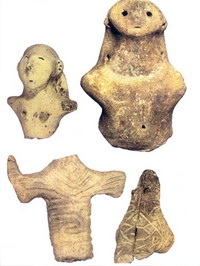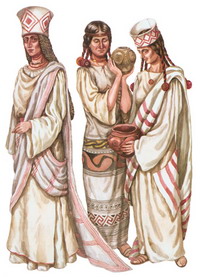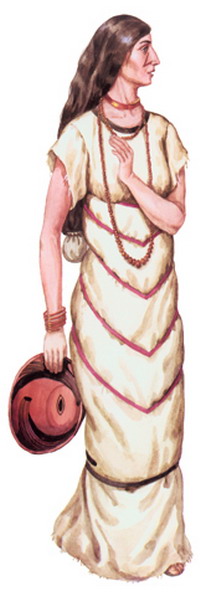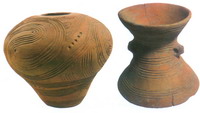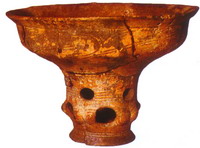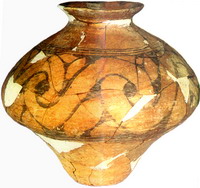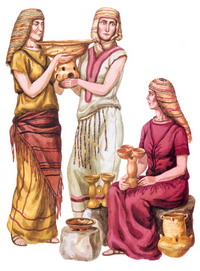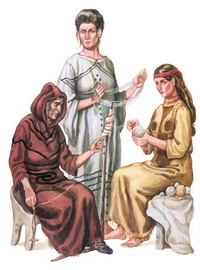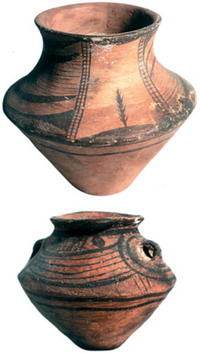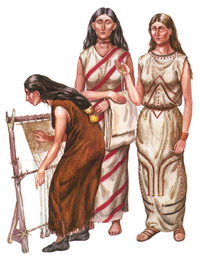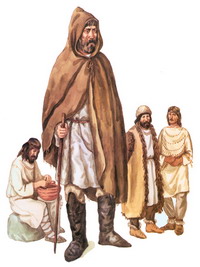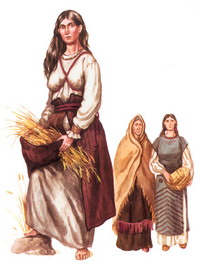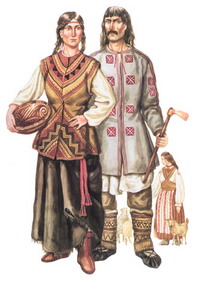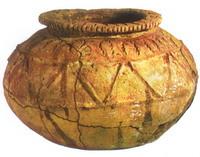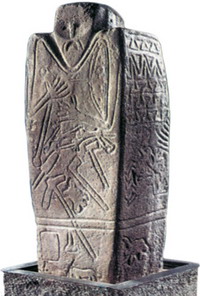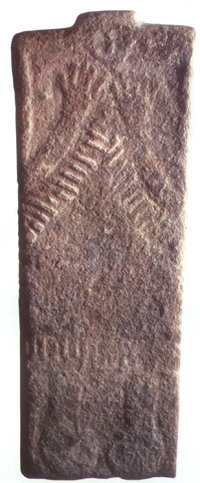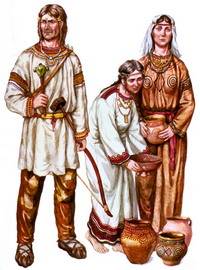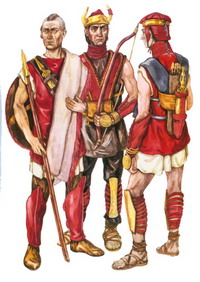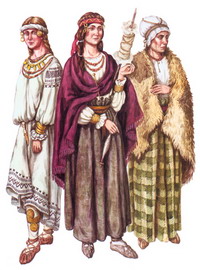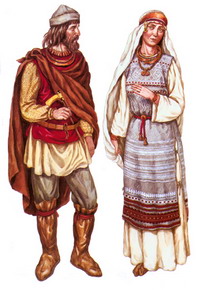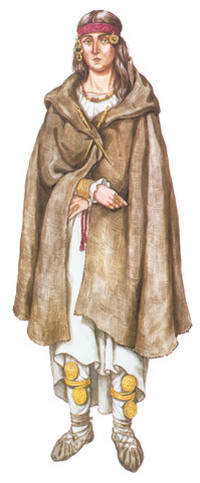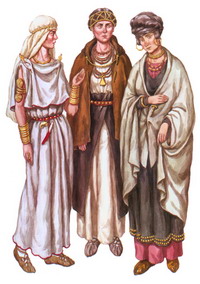earliest farmers and herders in Ukraine
Plan presentation
- Crisis hunting society.
- life for Mesolithic people.
- spread of agriculture and cattle on the lands of Ukraine for the Neolithic.
- Tripillian culture. Homeland and resettlement Trypillja. The economy and everyday life. Spiritual life.
- cattleman steppe. Serednostohivska culture. Yamna Bronze Age culture. Indo-Europeans.
basic concepts and terms
Archaeological Culture - a set of similar real balances, obtained during excavations that belong to the same historical time and territory. Similarity of form and decoration of tableware, decoration type, features and construction of dwellings rice burial ceremony indicate archaeological sites belonging to one nation or close to the people. The names of archaeological cultures are usually formed from the names of localities where it was first revealed typical sites (Slavic culture - from the village Chernyakhiv), or characteristics of archaeological finds (culture Globular Amphora, Corded Ware culture), the characteristics of Graves (Srubna culture). Defining Scope of archaeological cultures, scientists draw conclusions about ancient population settlement, establish roots and their origins, etc..
Mesolithic - Stone Age era, which was in transition between the Paleolithic and Neolithic. On the lands of Ukraine Mesolithic era lasted from about 10 thousand to 7 thousand years ago.
Neolithic - added a new stone age, the final stage of the Stone Age, who replaced Paleolithic and Mesolithic. Combine the era during which the person came to obtaining food, growing plants and animals odomashnyvshy. In Ukraine, it lasted from 7 thousand to 5 thousand years ago (5-3 BC), according to other data, begins in the plains of 6 thousand BC forest in 5 thousand BC ends in the plains in the first half of Article 4. BC In forest-steppe at the beginning of 3 thousand BC
Copper Age - copper-stone age - a transition link from Stone Age to the age of metals, when there are things made of copper - first metal, beset by a man, but a leading role in the manufacture of implements still belonged stone. In Ukraine eneolith took in 3.4 thousand BC
Bronze Age - a period in human history, when along with stone tools were distributed, bronze (copper alloy with tin, at least - lead, zinc, etc. ). In our area Bronze Age lasted from the beginning of 2 nd to the 1 thousand BC. e.
Timeline
|
4 thousand BC - Early 3 thousand BC. e. |
Tripol Culture |
|
Mid 4 th - mid 3 rd ths BC. e. |
Serednostohivska Culture |
|
middle of March - beginning of 2-thousand BC. e. |
Yamna Culture |
main presentation
1. Crisis Wildlife Society
|
of 16 thousand years ago began a gradual warming. Glacier melt, releasing coat of ice and new earth. The air became warmer and more humid, increased water in the rivers, marshes appeared. Dry steppe turned into marshy tundra, sometimes covered with birch-pine groves. Some animals unsuited to the new climate conditions, dead. Such a fate befell, including woolly giants - mammoths, rhinoceroses, bison, vivtsebykiv. Many holodolyubnyh animals away to the north. territory of Ukraine became the land of reindeer. |
Deer Hunters - arranged big collective hunt, vystezhuyuchy animals during seasonal transitions. Mass pokolky (from cracking) reindeer occurred mainly when the animals get across the river.
- Doba hunters of reindeer in the lands of Ukraine in comparison with previous epochs of ancient history was very brief.
- glacier retreated further and further north, causing profound changes in the nature of the planet.
About 10 thousand - years ago in Europe vstanovyvsya climate similar to modern.
Middle - to become modern and fauna. Reindeer ever left our land. In the pine and birch forests settled moose, deer, tours, wild boar and more. There was a day forest hunters .
2. People's lives for the Mesolithic
- end of the Ice Age coincided with the end of the Paleolithic. The next day in the history of mankind Archaeologists called Mesolithic .
- Animals, which took the reindeer, never gathered in large herds or flocks. So, hunting has become a hassle and painstaking work. For hours and sometimes days had spy hunter prey. However Legally Harvested enough meat for long. In search of prey forest hunters moved from place to place, building temporary housing.
- hunters of that era were taught to use onion and arrows - so were able to aim and shoot at animals from afar .
- to outfit hunters align winter skiing . People also used the Mesolithic period boats .
- And, as researchers believe, that at that time was tame dog - an assistant during the hunt.
- Tools hunting made of wood, bone, horn and flint. Tiny sharp flint plastynochky were fixed in a bone or wooden base. It produced knives, spears, harpoons, arrows.
- Forest hunters lived in the northern part of Ukraine.
- the south lives differed slightly, which stems from the other fauna and flora. There, in particular, has been collecting vahmishymy and fishing. Along the Dnieper River near the rapids nature was so much that people can have permanent residence. In Crimea, as evidence by many archaeological finds, people gladly obzhyvaly caves and grottos.
3. The spread of farming and cattle on the lands of Ukraine Neolithic
- Over hundreds of thousands of years, people eat what nature gave them (actually, since the earliest human occupation - hunting and collecting - Scientists call pryvlasnyuvalnymy ).
- Agriculture and cattle given to using nature to grow new plants each year and increase herd domestic animals - that natural resources play.
- is why new species of human scientists had made an appointment call reproduction .
- Agriculture and animal husbandry have arisen in the last period of the stone age, it is called the Neolithic .
- territory of Ukraine does not belong to regions where there farming and cattle .
However, local hunters - over 8.6 thousand he took over as new kinds of human activities from residents of Central Europe, which in turn borrowed them from the settlers from the forefront of Asia. So the experience of farmers and ranchers of our ancient ancestors assimilated from different people.
- emergence of agriculture has pushed people to the invention of the first artificial material - Ceramics (baked clay). With her varied dishes made for the preservation of grain and cooking. Each of the people had their favorite form of pots and gave preference to patterns or so.
- Since ancient peoples names are not preserved, scientists posluhovuyutsya conditional use concept archaeological culture.
- Archeologists in our land by Neolithic and Bronze Age there were many branches of agriculture and animal husbandry. They belonged to different archaeological cultures, the centers are located in South-Western and Central Europe and the eastern lands of Ukraine were below their distribution.
- Only a people that through the Balkans prymandruvav probably from the Middle East, our land has become a second fatherland, because this is where their blooming economy and culture. It is about Trypillians .
- flourishing culture of Tripoli fell a day Bronze Age.





4. Tripol Culture
origin, resettlement, training
Name - Tripoli Culture , and thus are represented relative. It comes from the village of Tripoli in the Kyiv region, situated near the end of 19 century. Ukrainian archaeologist Vikentija Khvoiky discovered the remains of ancient life of farmers.
- Numerous archeological finds show that Trypillians, descendants of one of the ancient peoples of Asia Minor, came to the land of the Lower Danube region of Ukraine about 7 thousand years ago, then captured the vast expanses of the Dnieper River Dniester, reaching areas of Volhynia and the Black Sea steppe.
- Tripol culture existed in our lands almost fifteen hundred years - from 4 thousand BC the first half of 3 thousand BC It is the researchers associated with it the establishment of ancient Ukrainian territory reproductive economy.
- Archaeological findings indicate a high level of development of the reproductive economy in Trypillians . The basis of it was fallow Farming , which involved the use of any land until vycherpuvalasya their fertility.
Leaving - depleted areas, farmers moved further east, thus gradually mastered all suitable for agriculture black from the Carpathians to the Dnieper.
- Trypillia sown barley, millet, wheat, grown in almost all well-known in Ukraine and garden culture. Land cultivated wooden hoe with stone or bone tip, and then - ralom. Used those apparently preferred traction force.
- yields collected bone or stone sickles . Grain ground it into flour using stone zernoterok . They knew Trypillians and animal husbandry. It is known that their tribes bred cattle, goats, sheep and pigs. A stable, secure life with food has led to improvement of life and creativity.
- Trypillia extremely well owned equipment making pottery. they ware pottery produced in special furnaces, and complex patterns painted black, brown, red, rarely white paint. In finishing ornaments Trypillian potters vplitaly image shapes of humans, animals and birds.
- Trypillians associated with the emergence of our lands industry - ie copper melting and casting things that they previously vykovuvaly of native copper.







Housing and settlement Trypillja. Social, and spiritual life
- trypiltsi achieved great skill in construction of housing. They lived in a quadrangular one-or two-storey house with several rooms.
- Trypillians their homes built like this: in the land vbyvalysya oak pillars, and between them with sticks erected walls obmazuvalysya clay, resting on top of poles is four, covered with straw or reed roof with a hole for the smoke.
- in every house built in a large oven (which sometimes could have been an open hearth), and near it - beds with baked clay. Wall oven and sometimes rozmalovuvalysya.
Archaeologists have found numerous - clay modelki tripillia dwellings. They, and the remains of dwellings allowed scientists to restore the appearance tripillia houses.
- Tripol populace lived families who are cooperating in community , and later in tribes . First Trypillians settlements were small.
- They lived for 50-60 people. Buildings located circle, with a detachment of cattle in the center. Later Trypillians began building giant village, where lived to 10 thousand shower. In such settlements, the so-called proto, concentric circles of houses constituted a sort of street.
In the village - Maidanetskiy Cherkashtyna archaeologists examined the remains of proto Trypillian. It occupied an area of 300-400 hectares and counted two thousand dwellings. Buildings placed ten concentric circles, separated by radial streets.
- also double dwellings, archaeologists discovered fortifications and public buildings, commercial and ritual pit.
- Scientists suggest that Trypillya community led leader . Small business he handled himself, and important - for all councils with adult community members.
- Archaeological finds testify later time some differences in the everyday things in different regions of resettlement Trypillja. This shows the association of related communities in tribes and the gradual formation tribal groupings .
- Trypillia praised the gods of thunder, sun, rain, wind. And worship the goddess of fertility, because it determined the fate of her future harvest. This is evidenced by the numerous female figurines that are found in almost every village Trypillian.















Tripoli Decline of Culture
- Although a high level reached Trypillian society, it gradually accumulating signs of decline.
Exhausted - earth ever gave lower yields, and new areas suitable for crops growing and there was.
So - proharchuvatysya Trypillians becoming increasingly difficult. Finally, not having learned to restore soil fertility, Trypillians dissolved among other nations.
- the middle of the 3 rd ths tripilska culture declined.
- great importance was the impact on local culture Tripoli hunting populace. Exactly Trypillians of our ancestors learned to grow wheat and acquire cattle.
Are - Potter adventure Trypillians skills and their knowledge of metals. However, learned from experience Trypillians incarnated in very different forms, usually simpler, because the decay of Tripoli culture of its features in these little trace.
Tripillian culture reached a high level of development, closely approached the origin of civilization - that is, a level of development of society, when there are cities and writing.
5. stockman steppe
Serednostohivska Culture
- Despite high levels of reproductive management in Trypillians, tripilska culture was not his only center on the lands of Ukraine.
Along with - Trypillians lived in the steppe zone serednostohivska humanity. From the view of other than the territories Trypillians, natural farming conditions serednostohivtsiv significantly different from Trypillian.
- Serednostohivska Culture there from mid April to mid-3 rd ths BC. e. in areas of steppe Dnieper Azov, in the basin of the Seversky Donets and in the Lower Don. The name comes from the tract average stack (now within the city of Kiev), where it was found that cultural monuments.
Since - desert conditions more suitable for cattle rearing, it is the foundation of the economy serednostohivtsiv.
- But residents knew the desert and agriculture. Land needed a sedentary life, and cattle in search of new pastures forced to move from place to place. To some extent overcome this contradiction gave you cattle pasture , which it seized serednostohivtsi.
- adult community members serednostohivtsiv did circle the earth, and young people and older people away for the summer season with cattle on pasture down the Dnieper. Autumn with flocks of cattle, they returned to the village.



Yamna Culture
- has gained increased importance in the life of cattle carriers Yamnaya culture - the population that lived in the desert of mid 3 rd to the 2 - On ths BC on the territory from the Urals to the lower course of the Danube. In Ukraine, the remains of the culture found in the basin of the Dnieper River, Azov Sea and Crimea.
His name - Yamna culture owes to the peculiarities of burial ritual. Departed yamnyky-herders were buried in pits, which poured over mounds . Each mound was ruled by generic tomb.
In yamnykiv - graves, archaeologists found the remains of chariots , indicating their use of wheeled transport. At large four-wheel Garba yamnyky carrying, traveling for cattle, stock food and tools.
The moving-- sedentary reflected in the worldview yamnykiv. Not having free time even in winter (because cattle need vigilant care for the entire year), left yamnyky sophisticated attractions: glassware, household utensils, ornaments in them strikingly simple.
- they ruled the temple mounds, built by the graves.
It - beside them ushanovuvaly ancestors sacrificed to the gods, and celebrated counsel. A mound pastoralists established and time boulders . Their little obtesuvaly, giving the appearance of human figures.
- greatest riches in cattle was yamnykiv. Researchers believe that carriers of the culture started growing animals for milk. Actually, this is facilitated ruhlyvishomu lifestyle.
- However, they refused completely from Farming, growing less demanding varieties of wheat, barley, millet and hemp.



Indo-European
In the steppe unlimited - among pastoral cultures of that era was the people who gave life to many modern people, including Ukrainian.
- Researchers called the people Indo-European .
- Indo-origin question is extremely complex and controversial. Its scientists studying different fields of knowledge: not only archaeologists and historians, and linguists, and for perhaps the history of Indo-Europeans would allow to explain the origin of many modern languages.
- Comparing modern languages Indo-European peoples and languages ancient monuments, researchers, linguists praindoyevropeysku restore long dead language.
- analyzing those objects and phenomena of the environment that are reflected in her words, comparing them with archaeological finds, historians concluded that the homeland of the Indo - Eastern European steppes.
- Praindoyevropeytsi were pastoralists, so soon settled in the vast territories. In remote tribal languages were the features that were not in common praindoyevropeyskiy language. It faces numerous Indo-European peoples and their languages.











So, in the Bronze Age in the steppe zone, in contrast to agricultural world (represented by a Trypillya culture), formed the world cattle. It is a pastoral steppe environment of researchers associated praindoyevropeytsiv - people who come from many modern Indo-European peoples, including Ukrainian.
 English
English













































